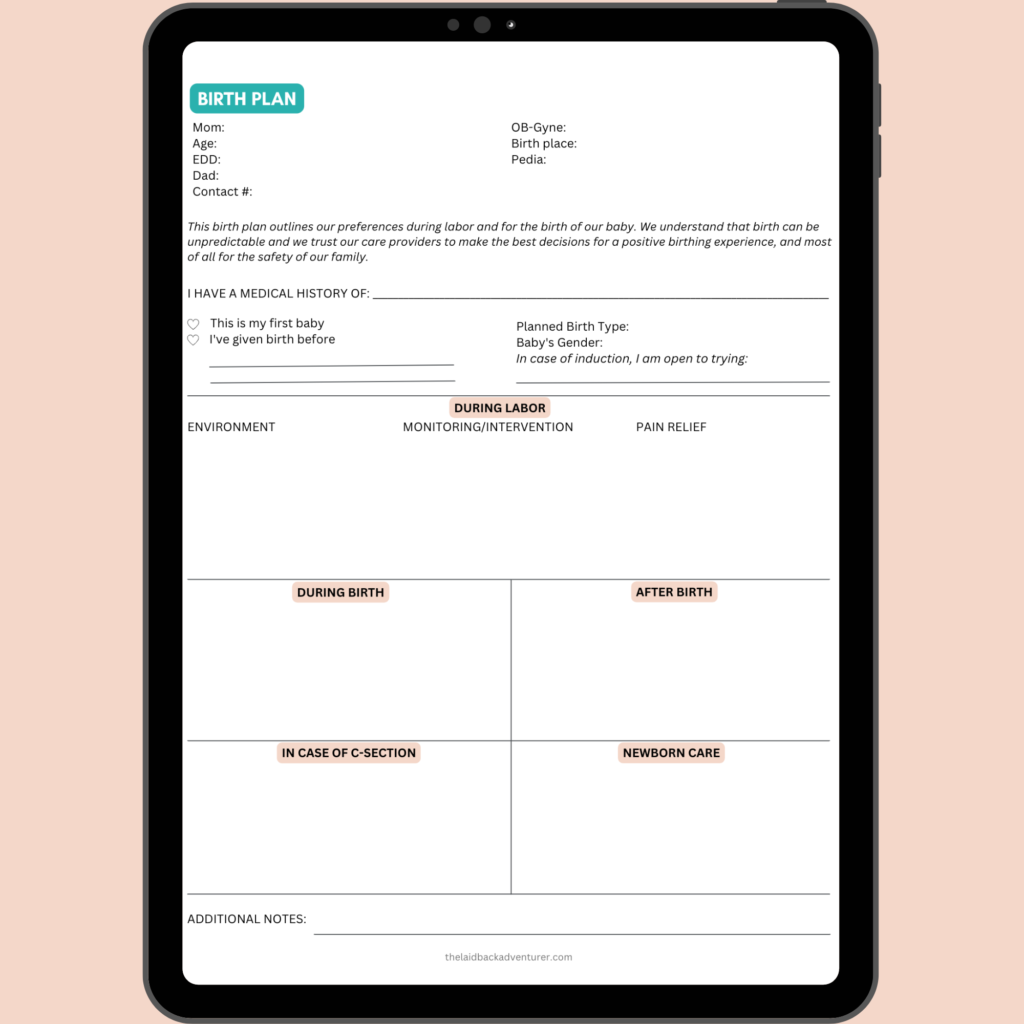5 Simple Ways I Prepared for VBAC
If you’re reading this, you might be interested or aiming for a VBAC. How did you learn about it?
I’m asking because many moms still don’t know that Vaginal Birth After Cesarean (VBAC) is possible. It’s not surprising since VBAC is still frowned upon by many doctors here in the PH and abroad. Some won’t even let a TOLAC (Trial of Labor After Cesarean).
Ideally, you should be doing your research before you are pregnant again. Knowing the benefits and risks associated with VBAC can help you decide for your future births.
I am not a childbirth educator or a doula. But I just got my VBAC having done these things below.
1. We looked for a VBAC-friendly doctor
Not all OB-Gynes are willing to do VBACs. This is why many moms are switching doctors after having a C-section.
After sharing with my husband the news about my second pregnancy, he jumped to Facebook to search for OB-Gynes who are VBAC advocates. That’s where we found the page of Dr. Cecile Francisco-Ordinario who holds clinics in my area.
I booked an appointment and on our first meeting, I was asked about the reason why I underwent a c-section.
There are some kind of criteria to know if you’re a candidate for VBAC. If you want, you can already bring your Obstetric Record/OR Technique (I’m not sure if it’s the same as the Abstract) and show it to your VBAC doctor. He or she will discuss the possibilities of a VBAC with you.
Prepare your questions too. Here are some you may want to ask:
- Will you induce my labor if I go beyond 40 weeks?
- Do you support VBAC after two cesareans or VBA2C?
- If I still end up having a c-section, will you let me have immediate skin-to-skin with my baby? (a.k.a the Golden Hour or Unang Yakap)
Have a care provider you are comfortable with. As your pregnancy progresses, you will most likely have more questions for her (“her” na lang tayo para consistent) beyond clinic hours. Even though doctors are on call and are always busy, the good ones will make time to reply to your messages.
2. I took a birth preparation class
Just because you’re not a doctor or a midwife doesn’t mean you don’t have to seek knowledge about the process of birth.
I didn’t take any birthing classes during my first pregnancy thinking my body will do what it should. Well, guess what? You can help your body do what it should. It starts with being educated.
There are tons to know about preparing your body for birth. Here are some of the things you can learn:
- ways to naturally induce labor
- comfort measures during labor
- the cascade of interventions, and so much more
The good news is you can find free resources online. I watched a lot of doula Bridget Teyler videos on Youtube. I also followed other doctors who share tips about VBAC.
There are also paid birthing classes (I took Doula Ros’s Birthing with Confidence which is online and self-paced) and some even have VBAC seminars.
Your healthcare provider may also give instructions to help prepare your mind and body for birth. My OB sent me videos of exercises and meditation that could aid me during labor and delivery.
3. I made a birth plan
Did you know that you can make a birth plan? Those who are pro-gentle birth will encourage you to make one.
A birth plan is a document detailing your preferences and desires about your upcoming labor and delivery. Do you want to walk around or eat while laboring in the hospital? You can put it here. You don’t want any anesthesia all the way? Write it down. Baby’s dad to cut the umbilical cord? Let them know through this paper.
Don’t forget that hospitals have their guidelines and policies. This is why after writing your birth plan, you should bring it to your OB and discuss it. See if you’re on the same page and that the hospital (or birthing center) will allow what’s in your birth plan.
Remember also that birth is unpredictable. Having a birth plan doesn’t mean it will be followed all the way through. But if you have a healthcare provider you fully trust to make the best decision for you and your baby, you will still likely have a positive birth experience.
When is the best time to make your birth plan? I read somewhere that the early third trimester would be good. If you need a template for your birth plan, you can get mine for free below.

Writing a birth plan?
Download this free template and fill it in with your preferences. Print it out and bring it to your next prenatal appointment.
Water Birth
If you are interested in water birth and are wondering whether VBAC candidates are allowed that option, the answer is yes. However, you might not be permitted this if you have an infection in your blood or other body fluids (UTI, GBS positive, Hepa B reactive) and other conditions. Also, very few hospitals allow water birth.
Suggested benefits of birthing in water include:
- relief from warm water during labor
- fewer chances of tearing in the perineum area
- closest to how a baby feels in the womb
4. (I tried to) Be fit and well
I saw this on Instagram.
What is something that feels like an Olympic sport but isn’t?
Answer: Pregnancy
Just how true is that? Haha. Preferably, you should be living a healthy lifestyle even before conception. I could have done better when it comes to exercise and nutrition.
After learning I was negative for Gestational Diabetes Mellitus during my recent pregnancy, I celebrated by drinking milk tea every week. It was the second trimester so I felt like I was allowed to indulge.
By 34 weeks, the ultrasound showed that my baby was big already. I had to cut back on my food or else I might have had to push a 3.9 kg newborn at 39 weeks.
You might have already researched what foods pregnant women should avoid. If something isn’t off the table, take it in moderation. Don’t skip your veggies and prenatal vitamins too.
Just like with food, there are also exercises that you should and shouldn’t be doing while pregnant. Most times your body just wants to lie down but stretching and walking can do wonders and make you feel better.
And did you know there is such a thing called “optimal fetal positioning?” I don’t know how to rephrase that but basically, you would want your baby to be in the best position for an easy way out during birth.
When I was pregnant, I was always trying to sit straight or lean forward. It alleviates back pain and makes for a roomier space for the baby. This way I was helping him have an optimal fetal positioning (and encouraging him not to be breech).


Labor and delivery take a toll on a birthing woman’s body. This is why you need to be fit so you can also assume different positions to help you during labor.
Catch some sunlight too in the early morning. It’s a pick-me-upper.
5. I relaxed and let go
Even though you are excited and determined to birth vaginally, there will be times when you will doubt if you can do it. And it’s normal because you haven’t experienced it before.
Take a step back and remember your body is built to birth. Slow down and read positive birth stories every day if you can.
You may also join online groups and read inspiring stories of moms who just had VBACs.
However, be open to the possibility of a repeat c-section. Even though the goal is VBAC, the priority remains to be a safe birth for mom and baby.
Try not to get anxious when you are near your due date. The baby will be born when the baby is ready. Besides, worrying only wastes your time.
My most relaxing thought was knowing God is in charge. I trust that He’s got my back (and belly and everything).
If you have extra money, have a doula with you. I’ve never had one but imagine their contribution to your physical and mental well-being during labor and birth.
I did my part in preparing for my VBAC. I had a supportive birth team too. It was like a recipe for success, though ultimately it was the Lord God granting our prayers.
Why go for a VBAC?
When I attended a free webinar hosted by Doula Ros last March, we were asked why we wanted a VBAC. I thought the most popular answer would be to skip the C-section pain during recovery. To my surprise, attendees had different answers.
Some just want to experience normal delivery. Some are afraid to go under the knife again. Some want to recover faster so they can take care of their older children immediately as well.
I don’t consider my first birth traumatic. But if I had to compare it with my recent delivery, VBAC is so worth it.
So will you attempt a VBAC? If you will, I very much hope you succeed.




